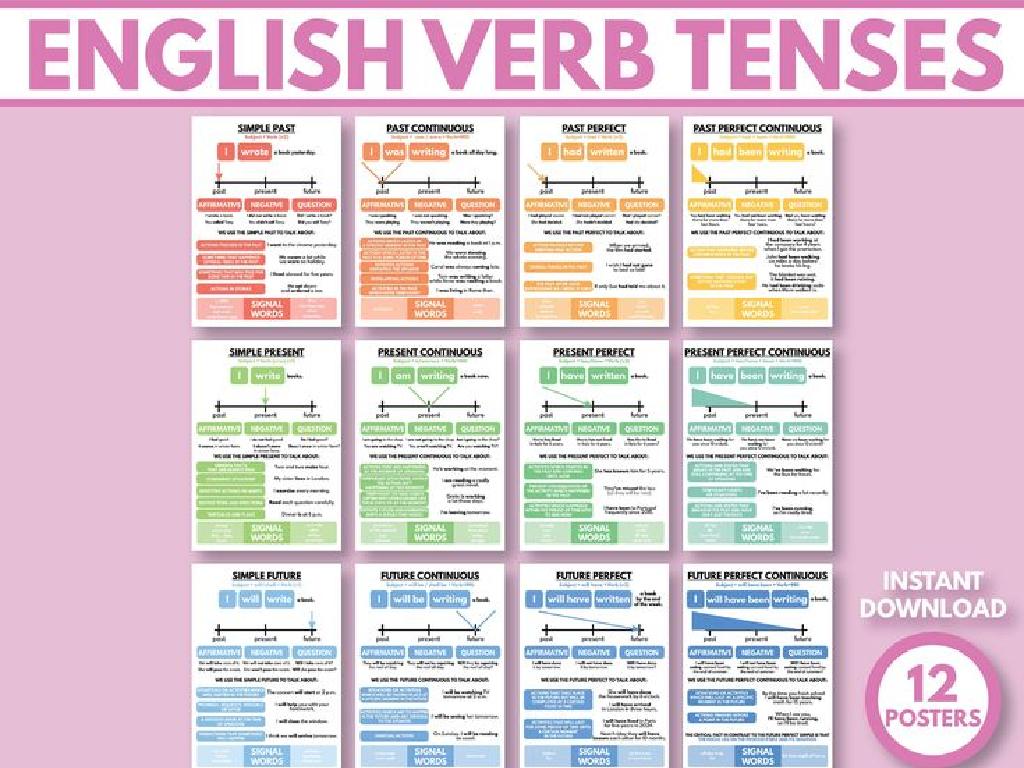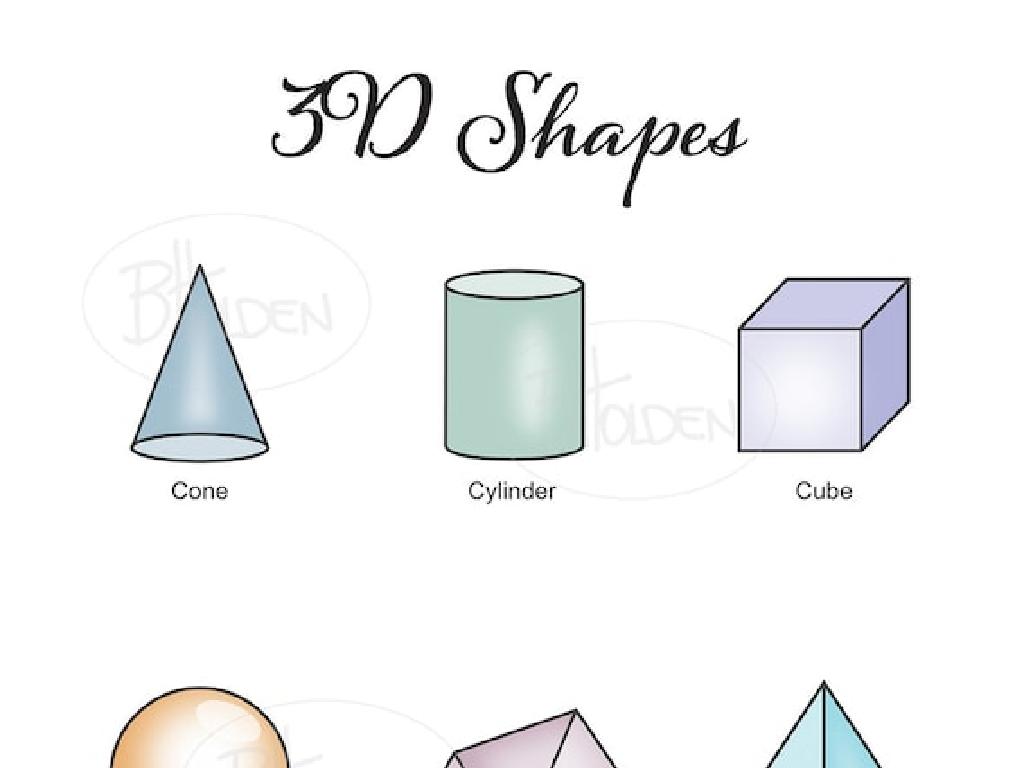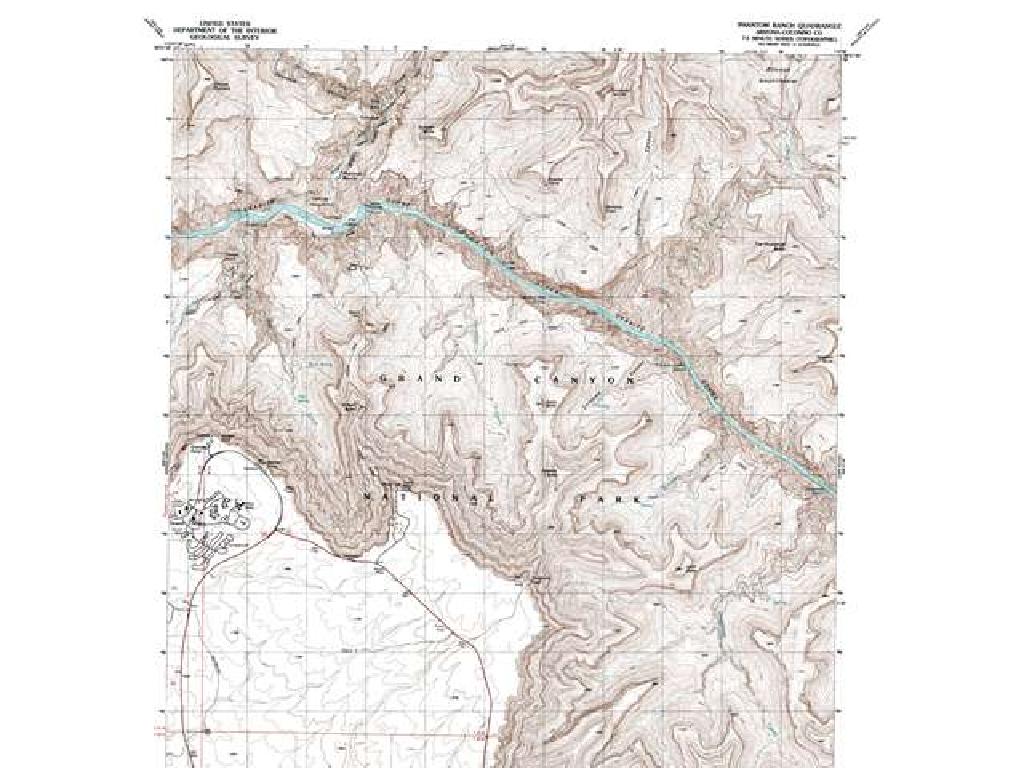Sides And Angles Of Quadrilaterals
Subject: Math
Grade: Fourth grade
Topic: Quadrilaterals
Please LOG IN to download the presentation. Access is available to registered users only.
View More Content
Exploring Quadrilaterals: Sides and Angles
– Define a quadrilateral
– A shape with four sides and four angles
– Count sides and angles
– Each quadrilateral has 4 sides and 4 angles
– Real-life quadrilateral examples
– Think of a kite, a window, or a computer screen
– Quadrilateral properties
– Angles add up to 360 degrees; sides can be equal or different
|
This slide introduces students to the concept of quadrilaterals, focusing on their sides and angles. Begin by defining a quadrilateral as a four-sided polygon, and then engage the students in counting the sides and angles of various quadrilaterals. Provide relatable examples that they encounter in their daily lives, such as kites or windows, to solidify their understanding. Discuss the properties of quadrilaterals, such as the sum of interior angles always being 360 degrees and the possibility of having sides of equal or different lengths. Encourage students to identify and draw different quadrilaterals, noting their sides and angles.
Exploring Quadrilaterals
– Quadrilaterals: 4 sides, angles, vertices
– Think of it like a four-cornered shape
– Angle sum always 360 degrees
– No matter the shape, angles add up to 360°
– Regular vs. Irregular quadrilaterals
– Regular have equal sides/angles, irregular do not
|
This slide introduces students to the basic properties of quadrilaterals. Emphasize that quadrilaterals are four-sided figures, which also means they have four angles and four vertices (corners). The key point to remember is that the sum of the interior angles of any quadrilateral adds up to 360 degrees, a fact that can be proven by dividing the quadrilateral into triangles. Discuss the difference between regular quadrilaterals, like squares, where all sides and angles are the same, and irregular quadrilaterals, like kites, where sides and angles can vary. Use visual aids to help students remember these properties and encourage them to draw their own examples.
Exploring Quadrilaterals
– Quadrilateral Family Members
– Squares, Rectangles, Rhombuses, Trapezoids, Parallelograms
– Sides & Angles of Each Type
– Count sides & measure angles with a protractor
– Finding Quadrilaterals Around Us
– Look for real-life examples of quadrilaterals
– Class Activity: Quadrilateral Hunt
|
Introduce students to the different members of the quadrilateral family, emphasizing the unique properties of squares, rectangles, rhombuses, trapezoids, and parallelograms. Explain that all quadrilaterals have four sides and show how to identify and measure their sides and angles. Encourage students to observe their surroundings and find examples of each type of quadrilateral in real life. For the class activity, have students search their classroom or home for quadrilaterals and document their findings with drawings or photos. Provide guidance on how to safely use a protractor to measure angles. Suggest that students work in pairs or small groups to foster collaboration.
Exploring Quadrilaterals
– Squares: 4 equal sides, 4 right angles
– Example: A chessboard has squares
– Rectangles: Opposite sides equal, 4 right angles
– Example: Your classroom door is a rectangle
– Rhombuses: 4 equal sides, angles vary
– Example: A diamond shape is a rhombus
– Trapezoids: 1 pair of parallel sides
– Example: A kite with two different length pairs
– Parallelograms: Opposite sides parallel and equal
|
This slide introduces students to the properties of various quadrilaterals. A square is a regular quadrilateral with all sides and angles equal, often seen in floor tiles. A rectangle, like a square, has right angles but only the opposite sides are equal, similar to many doors. A rhombus has equal sides but angles that are not necessarily right, resembling a diamond. A trapezoid, with only one pair of parallel sides, can be likened to a kite. Lastly, a parallelogram has opposite sides that are both parallel and equal, which can be seen in certain tiles. Encourage students to find these shapes in their surroundings and bring pictures or examples to class. This will help them relate the mathematical concepts to the real world.
Exploring Angles in Quadrilaterals
– Measuring angles with a protractor
– Place the center of the protractor on the vertex of the angle and align with one side
– Practice measuring quadrilateral angles
– Use your protractor to measure each angle in various quadrilaterals
– How to find a missing angle
– Subtract the sum of known angles from 360° to find the missing angle
– Sum of angles in a quadrilateral
– Remember, all quadrilaterals’ angles add up to 360°
|
This slide introduces students to the concept of measuring angles using a protractor and applying this skill to find angles in quadrilaterals. Begin with a demonstration of how to correctly use a protractor. Then, allow students to practice measuring angles in different quadrilaterals, reinforcing the technique. Discuss strategies for finding missing angles, emphasizing that the sum of angles in any quadrilateral is 360°. Provide several examples with one or more angles missing for students to solve. Encourage students to explain their reasoning as they work through the problems.
Class Activity: Quadrilateral Hunt
– Explore the classroom for quadrilaterals
– Match objects to quadrilateral shapes
– Draw and label your findings
– Sketch the objects and write names like square, rectangle
– Note sides and angles on each shape
– Count sides and measure angles if possible
|
This interactive activity is designed to help students recognize quadrilaterals in their environment. Encourage them to look for squares, rectangles, trapezoids, and other four-sided figures in the classroom. They should draw the shapes they find and label the sides and angles. This will help them understand the properties of different quadrilaterals. Provide them with tools like rulers for measuring sides and protractors for angles if available. For the discussion, ask students to explain why they classified the objects as they did and what characteristics they observed. This will reinforce their understanding of quadrilaterals and their properties.
Quadrilateral Art Project
– Create quadrilateral artwork
– Cut and glue colored quadrilaterals
– Use scissors to cut shapes like squares, rectangles, and trapezoids
– Explain your art’s sides and angles
– How many sides does each shape have? What about the angles?
– Present your artwork in class
|
This class activity is designed to combine creativity with geometry. Students will use colored paper to create an art piece composed of different quadrilaterals, such as squares, rectangles, rhombuses, and trapezoids. They should cut out these shapes and glue them onto a larger paper to form a creative design. Once completed, each student will present their artwork to the class and explain the properties of the quadrilaterals they used, including the number of sides and the angles. For the teacher: Prepare colored paper, scissors, and glue. Assist students in identifying the quadrilaterals. Have a discussion on the properties of each shape. Encourage students to talk about the sides and angles of the shapes they used. Possible variations of the activity could include creating a collage of quadrilaterals found in magazines, drawing quadrilaterals to form a picture, or using technology to design a digital quadrilateral artwork.
Quadrilaterals: Review and Reflection
– Recap of quadrilateral properties
– A quadrilateral has 4 sides, angles, and vertices.
– Naming each quadrilateral’s features
– Discuss squares, rectangles, trapezoids, and their unique properties.
– Interesting facts about quadrilaterals
– Share an intriguing fact or concept learned today.
– Class sharing and discussion
|
This slide aims to consolidate the day’s learning by encouraging students to reflect on the properties of quadrilaterals. Start by reviewing the characteristics common to all quadrilaterals, such as having four sides, angles, and vertices. Then, ask students to recall specific properties of different quadrilaterals like squares, rectangles, and trapezoids. For example, all sides of a square are equal, while a rectangle has opposite sides that are equal. Encourage students to share one aspect of the lesson they found particularly interesting to foster engagement and assess their understanding. Conclude with a class discussion, allowing students to learn from each other’s insights and questions.
Homework Challenge: Exploring Quadrilaterals
– Complete the Quadrilateral Worksheet
– Identify and label various quadrilaterals
– Practice drawing different quadrilaterals
– Use a ruler for straight sides
– Focus on getting the angles right
– Measure angles with a protractor
– Show and tell your drawings next class
|
This homework assignment is designed to reinforce the concepts learned about quadrilaterals. The worksheet will help students identify different types of quadrilaterals based on their sides and angles. Encourage students to practice drawing quadrilaterals with precision, using a ruler and a protractor to ensure accuracy in angles and side lengths. Remind them that quadrilaterals have four sides and that the sum of the internal angles is always 360 degrees. In the next class, students will have the opportunity to present their drawings, fostering a sense of accomplishment and allowing for peer learning. Provide a variety of quadrilateral examples for students to practice with, such as squares, rectangles, and parallelograms.






